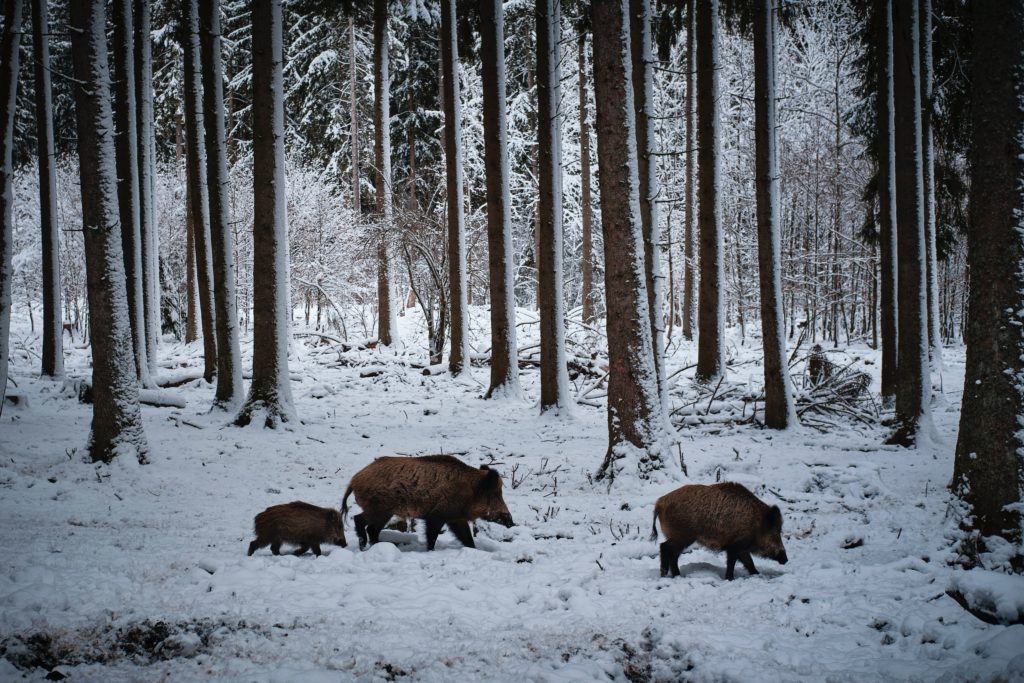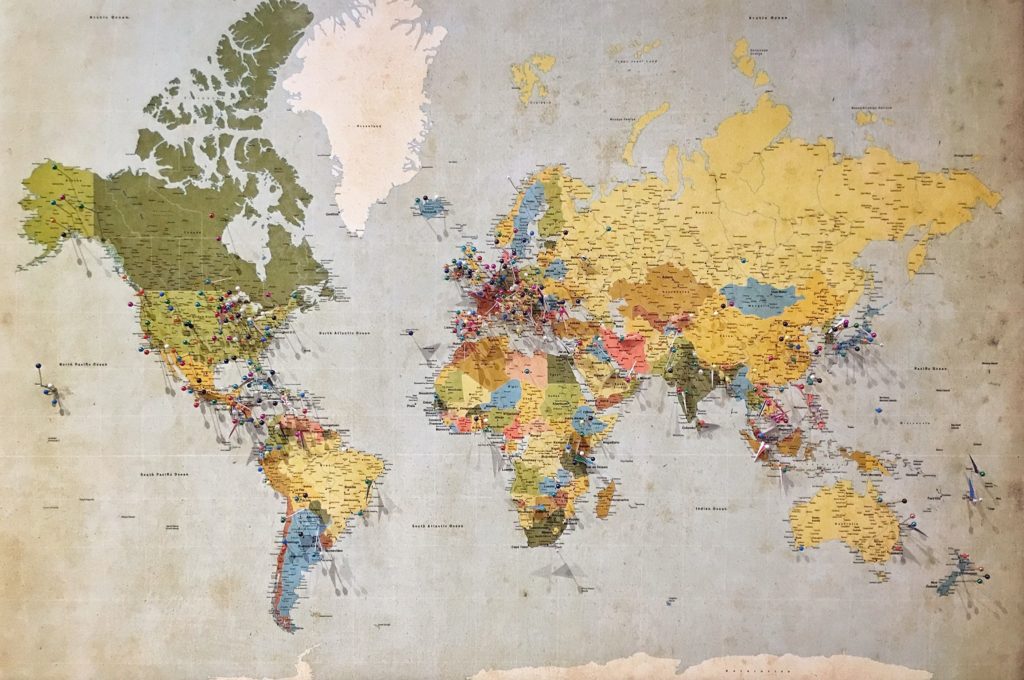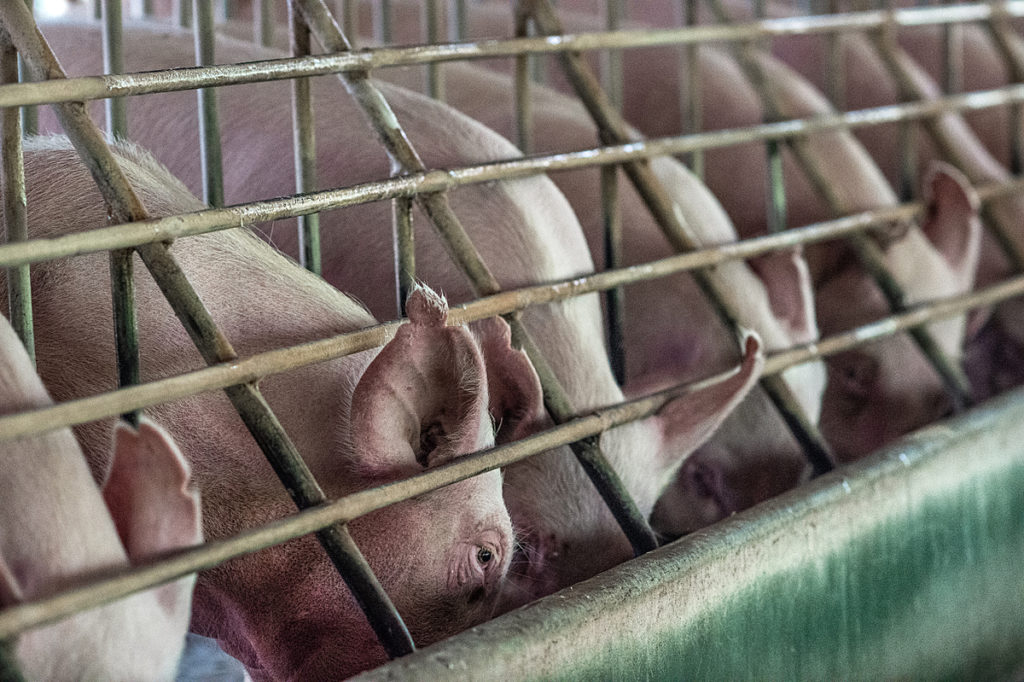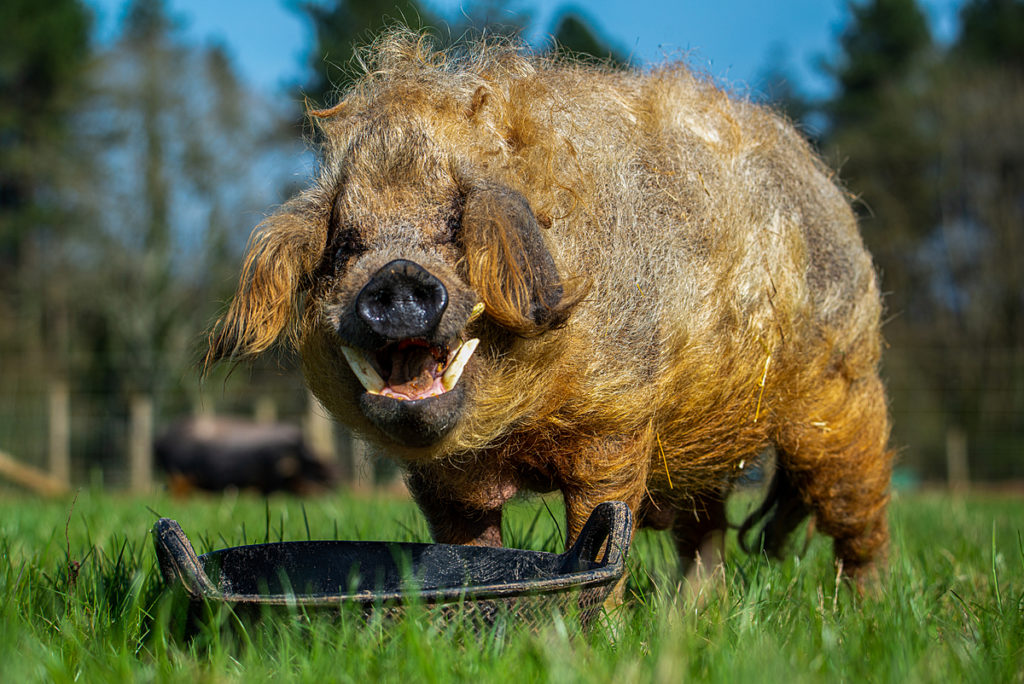Where Do Pigs Come From? A Not So Boar-ing History

Pigs belong to the scientific genus known as Suidae, a group of hoofed mammals commonly referred to as pigs, hogs, or boars, who appeared on Earth sometime between 20-35 million years ago! Depending on the source, it’s believed there are between 14 to 19 distinct species of suids that exist today. One of those is the wild boar (Sus scrofa), who is the living wild ancestor of the modern domesticatedAdapted over time (as by selective breeding) from a wild or natural state to life in close association with and to the benefit of humans pig (Sus scrofa domesticus). Though wild boars likely originated in Southeast Asia and subsequently spread throughout Eurasia and North Africa, they were forcibly bred and introduced to nearly every part of the world except Antarctica.
Like domesticated pigs, wild boars are socially complex beings that usually prefer to live in environments with lots of shrubbery, trees, tall grass, and easy access to water. However, they can live and thrive in a vast array of habitats ranging from tropical islands to boreal taigas, grasslands, mountainous regions, and even deserts! They typically live in matriarchal families known as sounders, which consist of several interrelated females, their babies, and occasionally a few males. With the exception of mating season and the occasional safety check-in, fully grown males usually prefer to live alone. Wild boars are most active at night, and spend a great deal of their time foraging for foods like fruits, nuts, grasses, roots, bulbs, and grubs underground. They regularly take baths in muddy wallows to cool off and find refuge from irritating insects. They also communicate with one another frequently through a range of call types, including grunts, snorts, snarls, and squeals. During the day, wild boars like to rest in sheltered areas and communal nests that are sometimes occupied by whole families. They can live up to 20 years old!
Pig Domestication: A Series of Un-porcine-ite Events

Researchers believe wild boars became domesticated by humans in at least three separate historical events. The first event took place in Central Asia near the Tigris Basin in what is now known as Turkey sometime between 10,000 and 15,000 years ago. A second domestication event occurred in China about 8,000 years ago. Then, sometime around 6,500 years ago, the farmers from the Tigris Basin migrated with the pigs they had domesticated to Northern Europe, where they subsequently interbred them with local European wild boars. This resulted in a third unique domestication event and the development of the European domesticated pig. In all three events, pigs were domesticated and used primarily as a source of food. Over the course of thousands of years, various cultures continued to selectively breed and spread them all over the world via migration, trade, and colonization.
Despite having originated in Central Asia, domesticated pig populations declined in this area sometime around 1,000 B.C.E. primarily as a result of religious restrictions on eating them. In Europe, however, exploitationExploitation is characterized by the abuse of a position of physical, psychological, emotional, social, or economic vulnerability to obtain agreement from someone (e.g., humans and nonhuman animals) or something (e.g, land and water) that is unable to reasonably refuse an offer or demand. It is also characterized by excessive self gain at the expense of something or someone else’s labor, well-being, and/or existence. and consumption of domesticated pigs vastly increased. Between the years 1400 and 1700, massive colonization efforts led by people like Christopher Columbus, Hernando De Soto, Hernán Cortés, and Sir Walter Raleigh forcibly introduced European domesticated pigs to almost all areas of the Americas as a source of food. By the early 1800s, animal exploitation had industrialized in many parts of the world and selective breeding of pigs and many other farmed animalsA species or specific breed of animal that is raised by humans for the use of their bodies or what comes from their bodies. skyrocketed. Large stockyards, slaughterhouses, and packing facilities became centrally-located in major cities, and innovations in transportation like refrigerated train cars made it easier and faster to transport animal flesh over wider geographic areas.
Modern Pig Farming

Sadly, domesticated pigs are one of the most commonly exploited animals in the world today, farmed primarily for the consumption of their flesh, called “pork”, but also for their bones, hide, and bristles to make things like paint brushes, footballs, gauze, and bone china. Unfortunately, they are also frequently exploited as petsAnimals who spend regular time with humans in their home and life for companionship or human pleasure. Typically a small subset of animal species are considered to be pets by the general public., and in biomedical research because they are so biologically similar to humans. Modern operations that exploit domesticated pigs have been able to exert unfathomable control over their bodies and behaviors through a myriad of cruel practices in order to maximize profit. Unfortunately, this has come at the cost of the pigs’ well-being, leaving them to suffer miserably throughout their shortened lives. Though they are cognitively and behaviorally very similar to wild boars – highly social, emotional, and intelligent animals who spend most of their lives exploring and rooting in the soil with their families – the majority of farmed pigs are prohibited from expressing their natural instincts and desires. This puts enormous stress on them, both internally and externally, leading to serious mental illness, trauma-related injuries, disease, and premature death.
Today, there are close to one billion domesticated pigs being exploited at any given time, 95% of whom spend their shortened lives inside factory farmsIntensive agricultural operations that prioritize large volume animal product production using strict production methods, typically away from the public eye. on concrete or slatted floor pens with thousands of other pigs. Although many modern domesticated pig breeds can live up to ten to fifteen years of age, most of them are killed at less than a year old.
The Importance of Sanctuary: Time to Re-root

In some areas of the world, pig exploitation and consumption is slowly decreasing, while in other areas, it’s rapidly increasing. This leaves us with the important task of understanding why this is happening and how we can stop it from increasing. One way we can do this is by learning more and teaching others about pigs through compassionate educational resources like sanctuaries for farmed animals, books, videos, and articles like this. Another way we can do this is by modeling an alternative way of being in relationship with pigs that honors them as individuals deserving of a life free from harmThe infliction of mental, emotional, and/or physical pain, suffering, or loss. Harm can occur intentionally or unintentionally and directly or indirectly. Someone can intentionally cause direct harm (e.g., punitively cutting a sheep's skin while shearing them) or unintentionally cause direct harm (e.g., your hand slips while shearing a sheep, causing an accidental wound on their skin). Likewise, someone can intentionally cause indirect harm (e.g., selling socks made from a sanctuary resident's wool and encouraging folks who purchase them to buy more products made from the wool of farmed sheep) or unintentionally cause indirect harm (e.g., selling socks made from a sanctuary resident's wool, which inadvertently perpetuates the idea that it is ok to commodify sheep for their wool). and exploitation. Animal sanctuaries can play a critical role in this endeavor by caring for pigs in a way that carefully considers the complexities of their current existence. While they are physically, cognitively, and behaviorally very similar to their wild boar relatives in many ways, domestication and modern farming has had a significant impact on their physical and mental well-being.
Currently, there are over 300 different domesticated pig breeds, each selectively bred by humans for different human desires and specific attributes. While most have been bred to grow dramatically larger than their wild ancestors for human consumption, other breeds have been bred to grow smaller to be used as “pets” and victims of biomedical research. When it comes to caring for pigs, it is imperative that sanctuaries consider these aspects of their current existence as well as all of the other potential effects breed-specific domestication and farming has had on them so that they can provide them with the most appropriate healthcare, diet, living space, and enrichment. Here are the most commonly-exploited categories of domesticated pigs and some of their attributes that are critical for sanctuaries to understand and consider.
Large Breed Pigs
Large breedDomesticated animal breeds that have been selectively bred by humans to grow as large as possible, as quickly as possible, to the detriment of their health. pigs, also sometimes referred to as “farm pigs”, are the most commonly exploited domesticated pigs in the world. Common large breed pigs include Yorkshire, Landrace, Giant White, Pietrain, Chester White, Spot, Poland China, and Hampshire. Most modern agricultural operations that exploit them breed them for their flesh, measuring corporate success by how many they can breed and how fast they can make them grow in extremely confined indoor settings. Although they are typically raised and killed in less than a year after birth, large breed pigs can actually live over ten years with proper care and good fortune. When they are allowed to live and fully grow, large breed pigs can weigh anywhere between 600 and 900 pounds, and some even bigger than that. As a result of being selectively bred to grow extremely fast and gain an exorbitant amount of weight in a very short period of time, these pigs regularly suffer from health-related issues such as foot and leg ailments, overheating, skin cancer, and reproductive illnesses. For sanctuaries that care for large breed pigs, it’s imperative that they consider the importance of providing proper hoof care, sun protection, and reproductive healthcare such as spaying and neutering. As with all pigs, it’s also important for sanctuaries to consider their size, individual preferences, and various temperaments as they are interacting with them.
“Heritage” Pigs
In modern agricultural terms, “heritage” pigs are defined as pig breeds that are or have been endangered (according to the LivestockAnother term for farmed animals; different regions of the world specify different species of farmed animals as “livestock”. Conservancy), have had an established and continuous breeding population in the United States since 1925, and are registered as “purebred”. Common heritage breeds include Duroc, Red Wattlea fleshy pendulous process usually about the head or neck (as of a bird), Berkshire, Tamworth, and Large Black. Like large breed pigs, “heritage” pigs are also selectively bred for human consumption, making them similar in terms of size and temperament. As such, they require care considerations that are very similar to large breed pigs in terms of potential health-related challenges, diet, living space, and enrichment. However, they are unique in that they have been less dramatically bred for industrial efficiency, and thus, have retained many qualities of older pig breeds that had been originally introduced to the United States during the colonial era.
Potbellied Pigs
Originally found in Southeast Asia, researchers believe potbellied pigs were originally domesticated for human consumption sometime around 6,500 to 8,000 years ago. Although they are still farmed for their flesh, potbellied pigs are also commonly exploited and bred as household “pets”, particularly since the late 1980s in places like the United States. Common potbelly breeds include the Vietnamese Í, Heo Moi, Mong Cai, and Co. Although they share a common ancestor (Sus scrofa), potbellied pigs are very different from their large breed cousins, most notably because they are much smaller in stature and generally grow to weigh somewhere between 100 and 200 pounds. They can also live as long as 20 years! Despite their difference in size from large breed pigs, potbellied pigs are typically considered to be at a higher risk of obesity and harmful eye-related issues such as “fat blindness” and entropion. It’s very important that sanctuaries who care for potbellied pigs carefully consider these differences along with their other unique needs and health challenges, as they can have a significant impact on their well-being. For more information regarding the unique needs and care considerations of potbellied pigs, please read our detailed resource on this topic here.
“Miniature” Pigs
The term “miniature” or “mini” pigThe term “mini pig” is used to categorize smaller breeds of pigs, such as Potbellies, Julianas, and Kunekunes, and to differentiate between these breeds and large breed pigs, such as Yorkshires, Landrace, or Hampshires, who are sometimes referred to as “farm pigs”. The descriptor “mini” can be a bit misleading- some breeds of mini pigs can weigh over 200 pounds! Terms like “teacup”, “micro”, “pocket”, “nano”, and “micro mini” are deceptive terms that are sometimes used to intentionally mislead people into thinking an individual pig will remain a certain size. is used to categorize smaller breeds of pigs such as Potbellies, Julianas, and Kunekunes, and to differentiate between these breeds and large breed pigs. Unfortunately, the term “mini” is often used, along with other misleading terms like “teacup”, “micro”, “pocket”, “nano”, and “micro mini”, as a deceptive marketing tactic to exploit smaller pig breeds in the “pet” industry. Although many miniature pig breeds can grow to weigh up to and over 200 pounds, many breeders utilize harmful care tactics to convince potential buyers otherwise. Some of these tactics include extremely abusive dietary restrictions, inbreeding that creates catastrophic genetic consequences, and forcible impregnation at very young ages to make it appear that premature mother pigs are fully grown. People fooled into adopting these pigs are often shocked to watch them grow to their actual size and consequently, abandon them. In addition to being bred as “pets”, miniature pig breeds are also frequently bred for their flesh and biomedical research. Miniature pig breeds commonly exploited in biomedical research include the Hanford, Sinclair, and Yucatan. As with potbellied pigs, careful consideration needs to be made regarding the unique needs and care of other “miniature” pig breeds. Like large and “heritage” breed pigs, smaller breeds of pigs are also prone to reproductive-related health issues, so spaying and neutering is a health imperative.
Feral Pigs
Feral pigs are domesticated pigs, or descendants of domesticated pigs, who are no longer living in a domesticated environment. Although they are quite similar to their captive counterparts living in domesticated environments, feral pigs are treated and exterminated as pests in many parts of the world. When rescued as adults, feral pigs generally do not tolerate captivity well. However, when they are rescued young, they are sometimes able to adapt to human contact and life at a sanctuary, and live happily among other domesticated pigs. Sanctuaries who take in and care for feral pigs should carefully consider the most appropriate techniques and practices necessary for responsible care, as well as their unique physical, mental, and behavioral needs, particularly when it comes to safe cohabitation considerations. Like other domesticated pigs, their tusks should be trimmed regularly for the safety of other nonhuman and human sanctuary residents.
Laws and Regulations Concerning Feral Pigs
Regulations and restrictions concerning the housing of feral pigs vary by state and local law, and may limit whether or not your sanctuary can legally care for them. It’s important to consult knowledgeable local legal counsel so that you can clearly understand your state and local laws around this and make sure you are carefully considering and meeting all requirements.
Sources
Additional Care Recommendations for Older Pigs | The Open Sanctuary Project
Creating a Good Home for Pigs | The Open Sanctuary Project
Creating an Enriching Life for Pigs | The Open Sanctuary Project
Daily Diets, Treats, and Supplements for Pigs | The Open Sanctuary Project
Daily Observation for Pig Health and Well-Being | The Open Sanctuary Project
Domesticated, Feral, or Wild: What’s the Difference? | The Open Sanctuary Project
Hoof Care for Pigs | The Open Sanctuary Project
How to Safely Be Around a Pig | The Open Sanctuary Project
Pigs and Mud: Let Them Wallow! | The Open Sanctuary Project
Potbellied Pigs in Particular: Addressing Their Unique Needs
Potential Pig Health Challenges | The Open Sanctuary Project
Safe Cohabitation Considerations for Pigs | The Open Sanctuary Project
Spaying and Neutering Pigs: A Health Imperative | The Open Sanctuary Project
Techniques and Practices Necessary for Responsible Pig Care | The Open Sanctuary Project
The Importance of Sun Protection for Pigs | The Open Sanctuary Project
Feral Pigs Find Home at Ellis County Sanctuary | Green Source DFW
Pigs Learning Guide | Our Kith + Kin
Pig/Pork: Archaeology, Zoology, and Edibility | Pía Spry-marqués
The Domestication of Pigs: Sus Scrofa’s Two Distinct Histories | K. Kris Hirst
A Decade of Pig Genome Sequencing: A Window on Pig Domestication and Evolution | Martien A. M. Groenen (Non-Compassionate Source)
Definition of Heritage Swine and Pork Products | The Livestock Conservancy (Non-Compassionate Source)
What Is A Micro-Mini Pig? | North American PetAn animal who spends regular time with humans in their home and life for companionship or human pleasure. Typically a small subset of animal species are considered to be pets by the general public. Pig Association (Non-Compassionate Source)
Vietnamese Potbelly Pig | Oklahoma State University (Non-Compassionate Source)
Non-Compassionate Source?
If a source includes the (Non-Compassionate Source) tag, it means that we do not endorse that particular source’s views about animals, even if some of their insights are valuable from a care perspective. See a more detailed explanation here.
Source Disclosure
This article sourced information and inspiration from Our Kith + Kin, a single-member LLC run by Andie Springirth. Andie Springirth is also the author of this resource and Community Education Specialist at The Open Sanctuary Project. While her work with Our Kith + Kin informs her work with The Open Sanctuary Project and vice versa, they are in no way officially affiliated with or officially endorsed by one another.








